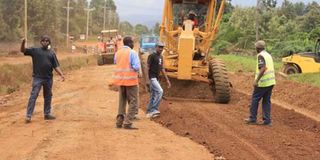Kiambu, Nairobi at bottom of cash list

Rehabilitation of the Marua-Nyeri road at Muruguru in Nyeri County on March 24, 2014. Counties at the Coast will get the highest allocation in proportion to their population while Nairobi will get the lowest. PHOTO | JOSEPH KANYI
What you need to know:
- The per capita allocation measures how much money each person in a county would get if the money was to be shared out equally
- Counties at the Coast dominate the list of devolved governments that will receive the highest allocation of devolved funds per person, according to the Revenue Bill, 2014
Kiambu and Nairobi are among counties that will get the lowest amount from devolved funds in proportion to their populations, according to the Revenue Bill, 2014.
Kiambu, whose governor, Mr William Kabogo, has been complaining about low allocation will have its residents receiving Sh4,004 per capita, the second lowest in the country after Nairobi.
Despite getting the highest overall allocation of Sh11 billion Nairobi county has the lowest per capital at Sh3,505 for its 3.1 million residents, which is likely to raise concerns as the majority live in slums that have no basic facilities like electricity, water and sewerage.
Nairobi Governor Evans Kidero has already raised charges for the residents saying the amounts allocated last year could not meet the county’s requirements.
Meru which has been allocated Sh5.7 billion in total will receive Sh4,203 per capita, also among the lowest allocation in proportion to its population. It will get less than Tharaka Nithi (at Sh7,391 per capita), Embu (Sh6,393) and Laikipia (Sh7,515).
The per capita allocation measures how much money each person in a county would get if the money was to be shared out equally. In development terms, a county like Nairobi, with a per capita allocation of Sh3,505 will spend less on development projects per person compared with a county like Isiolo which has a per capita allocation of Sh18,145, the highest in the proposed allocations to be released in the next financial year.
The Bill has proposed that Isiolo be allocated Sh2.6 billion. Although this sum will be lower than the Sh11 billion allocated to Nairobi, Isiolo will be in a position to spend more of its revenue per person because it has a bigger land area and a lower population than Nairobi. Isiolo has 143,294 people according to 2009 Census.
Under the current revenue sharing formula, 45 per cent of the devolved funds is shared on population basis, 25 per cent is shared equally among the 47 counties and 20 per cent according to poverty levels in respective counties. Another eight per cent and two per cent are allocated on the basis on land mass and fiscal responsibility respectively.
The Commission on Revenue Allocation has called for public views on how to develop a new revenue allocation formula.
“This will inform the preparation of the second generation revenue sharing formula to be used for the next five financial years,” a statement calling for the public to share their views said.
According to the figures, more money per person will go to residents in arid and semi-arid areas, uplifting the general living standards of the population there by providing social amenities like roads, energy and water, which is one of the objectives of the devolved funds.
Counties at the Coast — which are considered poorer by comparison to other regions like Nairobi — dominate the list of devolved governments that will receive the highest allocation of devolved funds per person, according to the Revenue Bill, 2014.
Lamu is one of the poorest areas in the country, ranked second after Isiolo.
In the next tranche of allocations, it will get the second highest per capita allocation of Sh16,742 while Tana River will be allocated an average of Sh14,162 per person once it receives the Sh3.4 billion to deliver services to its 240,075 residents.
Taita Taveta was ranked seventh nationally with the county residents allocated an average Sh9,836 per head.
However, Mombasa ranks poorly at seven from the bottom of the list of beneficiary at Sh4,790 per head on average, given its large population but small land mass.
Other counties that have high per capita allocation are Marsabit whose residents are set to get Sh15,455 after it was allocated Sh4.5 billion.
PERENNIAL DROUGHT
Samburu — which suffers from perennial drought — will see its residents receive Sh13,396 for its 223,947 people, with the total allocation of Sh3 billion. Turkana residents will get Sh10,638 per capita after it was allocated Sh9.1 billion for its 855,399 people. Wajir (Sh9,366), Busia (Sh8,927) and Garissa (Sh8,025), closed the top ten counties in terms of per capita allocation.
Most of the other counties have been allocated figures ranging between Sh4,500 to Sh6,000 per capita.
Kisumu county, home to 968,909 people, will see each resident allocated Sh5,057 and while those in the neighbouring Homa Bay will be allocated Sh5,084.
Migori has been allocated Sh5 billion which translates to Sh4,861 per capita, almost similar to Murang’a which has been Sh4.6 billion translating to Sh4,880 per capita.
Kitui has been allocated Sh6.3 billion that translates to Sh6,221 per resident and Makueni will get Sh5.1 billion (or Sh5,766 per capita). Machakos will receive Sh5,371 per resident for its 1.09 million people.





